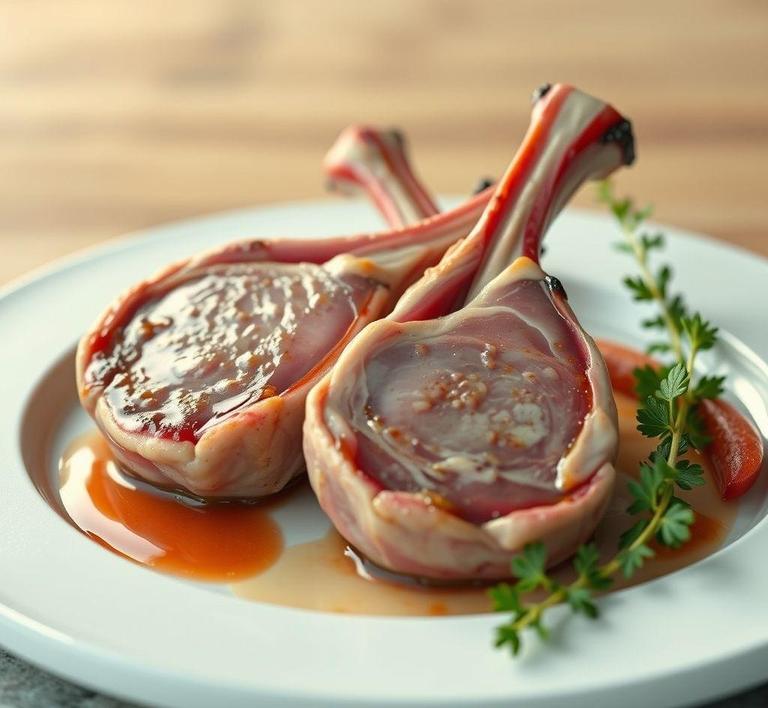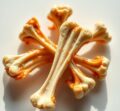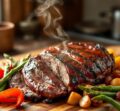So, you’re wondering if you can refreeze lamb chops? Well, the short answer is yes, but there are a few things you should know to make sure they stay safe and tasty. Refreezing meat can sometimes affect its texture and flavor, especially if it wasn’t thawed properly in the first place. In this guide, we’ll walk you through the do’s and don’ts of refreezing lamb chops so you can enjoy them just like fresh without worrying about any unwanted surprises!
Can You Refreeze Lamb Chops?

Lamb chops are a delicate cut of meat that often serves as the star of a meal, with their rich, tender texture and deep, savory flavor. Whether you’ve prepared more than you can eat or bought a large quantity of lamb chops on sale, you might find yourself wondering, “Can I refreeze lamb chops”? The simple answer is: yes, it’s technically possible to refreeze lamb chops, but it’s a process that requires careful consideration.
Refreezing meat in general, including lamb chops, isn’t always ideal because it can compromise both the quality and safety of the meat. However, it’s not strictly forbidden if done properly. The primary concern lies in the thawing and refreezing cycle, which can lead to bacterial growth or the breakdown of the meat’s texture and flavor. If the lamb chops were thawed in the fridge and have not been out at room temperature for too long (no more than 2 hours), refreezing is relatively safe, though it does come with some risks.
It’s also important to note that refreezing raw lamb chops that have already been cooked doesn’t present the same risks as raw lamb chops, though it still impacts the meat’s quality.
How To Refreeze Lamb Chops?
If you’ve decided to go ahead with refreezing lamb chops, it’s essential to follow proper procedures to minimize the negative effects of freezing and thawing. Here’s how you can safely and effectively refreeze your lamb chops:
-
Ensure Proper Thawing:
If your lamb chops were frozen initially, they must be thawed safely before you refreeze them. The best method is to transfer them from the freezer to the refrigerator and allow them to thaw slowly. This ensures the meat stays at a safe temperature during the process (below 40°F or 4°C). Never thaw lamb chops at room temperature, as doing so can allow harmful bacteria to grow.
-
Evaluate the Quality:
Before refreezing, check the condition of the lamb chops. If they’ve been left out too long, or if there’s any sign of spoilage (such as an off smell or slimy texture), they should not be refrozen and should be discarded. The freshness of the lamb chops directly impacts how they will hold up after being frozen again.
-
Wrap Them Properly:
The key to retaining the best possible quality when refreezing lamb chops is to minimize exposure to air. Air can cause freezer burn, which will negatively affect both the texture and flavor of the meat. For best results, wrap the chops tightly in plastic wrap, followed by aluminum foil, or place them in a vacuum-sealed bag. If you don’t have a vacuum sealer, consider using heavy-duty freezer bags and pressing out as much air as possible.
-
Label and Date:
To avoid confusion later on, be sure to label the package with the date the lamb chops were originally frozen. This will help you track how long they’ve been stored and ensure you use them within a safe period. Refrozen lamb chops should ideally be consumed within 3-4 months for the best flavor and quality.
-
Freeze Quickly:
After wrapping, place the lamb chops in the coldest part of the freezer to ensure they freeze as quickly as possible. This helps preserve the texture of the meat and prevents the formation of large ice crystals that can cause the meat to become mushy when thawed.
Quality Impact
Refreezing lamb chops can have a significant impact on their quality, and it’s crucial to understand what changes can occur.
-
Texture Changes:
The freezing process, particularly when repeated, can cause damage to the meat’s cellular structure. The ice crystals that form during freezing can puncture the meat fibers, leading to a softer, potentially mushy texture upon thawing. This is particularly true for lamb chops, which have a fine grain structure. While the texture may still be acceptable for stews or dishes where tenderness is less important, it might not be as pleasant for grilling or pan-searing, where the texture is more pronounced.
-
Flavor Deterioration:
The longer lamb chops are exposed to freezing and thawing cycles, the greater the chance that their flavor will be diminished. Freezing can lead to the loss of some of the natural flavors, and the second freezing process may cause even further degradation. Additionally, the risk of freezer burn-where the meat becomes dry and oxidized-becomes more pronounced with multiple freezes. This can result in an off-tasting, less flavorful chop.
-
Moisture Loss:
Each freeze-thaw cycle results in moisture loss from the meat. This is particularly important for cuts like lamb chops, where moisture is key to preserving tenderness. When refrozen, the lamb chops will likely lose more moisture, leading to a drier final product once cooked. If you’ve already frozen and thawed the lamb chops once, expect some loss of juiciness, especially in the more delicate parts of the meat, such as the bone-in sections.
-
Nutritional Impact:
Freezing and refreezing lamb chops doesn’t have a huge impact on their nutritional value, but there may be a slight reduction in vitamin content (such as vitamin C), though lamb is not a particularly rich source of this nutrient. The protein content, however, remains largely unaffected. Refreezing also doesn’t affect the fat content, but the texture and flavor changes could influence how the fat is perceived in the final dish.
While it’s possible to refreeze lamb chops, it’s not without its drawbacks. If handled properly-thawed slowly in the fridge, stored in airtight packaging, and used within a reasonable timeframe-the quality loss can be minimized. However, expect some changes in texture, flavor, and moisture content. The second freezing process will most likely impact the overall eating experience, especially if you plan to cook the lamb chops in a way where texture plays a central role, such as grilling or pan-frying.
If you’re looking for the best possible eating experience, it’s always better to plan ahead and freeze lamb chops only once. If you do need to refreeze them, be sure to use them within a few months for optimal flavor. Ultimately, your decision to refreeze will depend on your personal preferences and how you plan to prepare the lamb chops, but be mindful of the potential quality degradation that comes with this process.
Is It Safe To Refreeze Lamb Chops?
Refreezing lamb chops is a common concern for many home cooks and meat enthusiasts. After all, freezing and refreezing meat involves various risks and challenges to both safety and quality. The short answer to the question of whether it’s safe to refreeze lamb chops is: yes, but with caution.
However, there are several factors that need to be taken into account before making this decision. When lamb chops are thawed, the muscle fibers in the meat absorb moisture. This moisture can carry bacteria if the lamb was not properly stored or handled before freezing and thawing. While freezing can kill some types of bacteria, it doesn’t necessarily kill all harmful microorganisms, especially if the lamb has been left at room temperature for a period of time.
Safe Refreezing Guidelines
- Thawing Process: If lamb chops are thawed in the refrigerator, where temperatures are controlled and consistent, they can be refrozen without much concern. The key here is to avoid thawing lamb chops at room temperature, which can cause bacterial growth.
- Quality Considerations: While refreezing is generally safe from a food safety standpoint, it can affect the texture and flavor of the meat. The freezing and thawing process can cause the fat and muscle fibers in lamb to break down, leading to a drier and less tender cut of meat. Therefore, refreezing might not be the best option for preserving quality.
- Time Limits: Lamb chops that have been thawed in the fridge should ideally be used within 3-5 days. If you’re planning to refreeze them, make sure this time frame has not passed, as extended exposure to fluctuating temperatures can lead to bacterial growth.
Signs That Lamb Chops Should Not Be Refrozen
While refreezing lamb chops can be done safely under certain conditions, there are clear signs that the meat should be discarded rather than refrozen. Here are some key indicators to watch out for:
- Off Smell: If lamb chops have an unpleasant or sour odor, this is a clear sign that the meat has spoiled. The smell comes from bacteria or other microorganisms breaking down the meat, and refreezing it will not improve the situation.
- Slimy or Sticky Texture: When thawed lamb chops develop a slimy or sticky texture, this indicates bacterial contamination. The surface of the meat should feel dry to the touch, not wet or tacky. This is a major red flag and suggests the lamb has gone bad.
- Color Changes: Fresh lamb chops should be pinkish to red, depending on how recently they were butchered. If the meat has turned an unappealing grayish-brown or yellowish color, it may have been improperly stored or thawed, leading to spoilage. While slight discoloration might not be a dealbreaker, significant changes in color usually signal that the lamb is no longer safe to eat.
- Visible Ice Crystals: If the lamb chops are covered in large ice crystals after being thawed, it indicates they were thawed too slowly, likely in the fridge, and could have been exposed to fluctuating temperatures for a prolonged period. This can degrade the texture and taste of the meat, making it less suitable for refreezing.
- Long Time in the Freezer: If lamb chops have been in the freezer for an extended period (several months or more), they might still be technically safe to eat, but they’ll likely suffer from freezer burn. Freezer burn occurs when air gets into the packaging, causing the meat to dry out and become tough. At this point, refreezing may exacerbate these quality issues.
Common Refreezing Mistakes
Refreezing lamb chops may seem straightforward, but there are several common mistakes that can lead to less-than-optimal results. Here are a few to avoid:
- Thawing at Room Temperature: One of the most common mistakes is thawing lamb chops at room temperature. Leaving meat out at temperatures above 40°F (4°C) for extended periods encourages bacterial growth, which can lead to foodborne illness. Always thaw lamb chops in the fridge, or use a quick-thaw method like running cold water over the packaging.
- Refreezing Multiple Times: Each time you freeze and thaw lamb chops, you are introducing potential quality degradation. Refreezing the meat multiple times leads to a loss of moisture, tenderness, and flavor. If you plan to refreeze lamb chops, try to do so only once to maintain the best possible quality.
- Not Packaging Properly: If lamb chops are not tightly wrapped or sealed in an airtight package, air can cause freezer burn. It’s crucial to use proper packaging materials like vacuum-sealed bags or tightly wrapped plastic wrap, followed by aluminum foil or freezer paper. Without proper packaging, the lamb will dry out and lose flavor.
- Refreezing Immediately After Thawing: Refreezing lamb chops that have been left out at room temperature or have been partially cooked can lead to unsafe conditions. Meat that has been thawed and then cooked can be refrozen, but only once it has cooled down to room temperature. However, the key here is that it needs to be handled carefully to prevent bacterial growth during the thawing phase.
- Storing in a Freezer with Fluctuating Temperatures: If your freezer is not operating at a consistent temperature (0°F or -18°C), the lamb chops may thaw partially and refreeze, which can affect both safety and quality. This is why it’s important to regularly check your freezer’s temperature and make sure it’s working properly.
Tips And Tricks For Refreezing Lamb Chops
Refreezing lamb chops is an art that can be perfected with the right techniques. To ensure both safety and optimal quality, here are some tips and tricks:
- Use Proper Packaging: Always ensure that lamb chops are wrapped tightly in plastic wrap or aluminum foil. For added protection, vacuum-sealing is an excellent option to prevent air from reaching the meat and causing freezer burn.
- Label Your Meat: When refreezing lamb chops, label the packaging with the date they were frozen. This will help you track how long they’ve been in the freezer and avoid keeping them for too long. Ideally, lamb chops should be consumed within 3-4 months for the best taste.
- Thaw Gradually in the Fridge: Never rush the thawing process. The safest method is to place the lamb chops in the fridge for 12-24 hours, depending on the thickness of the cuts. This ensures that the meat remains at a safe temperature while it slowly defrosts.
- Cook Before Refreezing: If you want to ensure that lamb chops are still safe to eat after freezing, consider cooking them first. Cooking lamb chops to a safe internal temperature and then freezing them can help maintain safety and quality. Just make sure the cooked meat is cooled properly before refreezing.
- Avoid Refreezing Large Cuts: If you’ve thawed a large roast or a large package of lamb chops, it’s better to divide them into smaller portions before refreezing. Smaller portions thaw more quickly and evenly, reducing the risk of bacteria growth.
Conclusion
Refreezing lamb chops is a delicate process that requires attention to detail and proper handling to ensure both safety and quality. While it is generally safe to refreeze lamb chops that have been thawed in the fridge, it’s crucial to follow proper food safety protocols to prevent contamination. Always be mindful of how the lamb looks, smells, and feels, and never hesitate to discard meat that shows signs of spoilage.
By avoiding common refreezing mistakes, using the right packaging, and following best practices for thawing and cooking, you can confidently enjoy your lamb chops even after they’ve been frozen. With the right techniques, refreezing lamb chops can be a practical way to reduce food waste while maintaining the best possible flavor and texture. However, remember that the key to preserving the best quality lies in limiting how often you freeze and thaw your meat.


